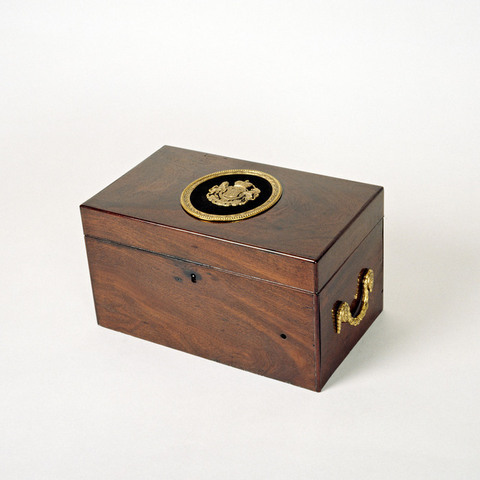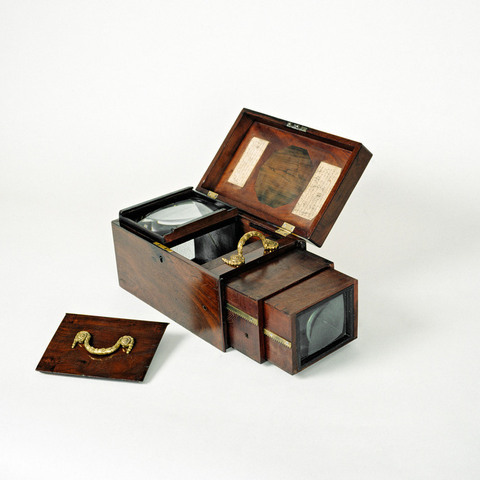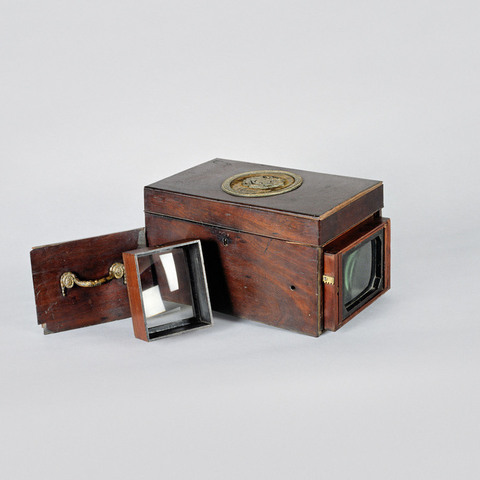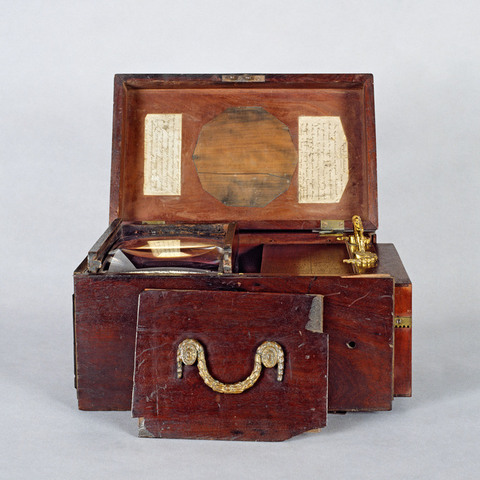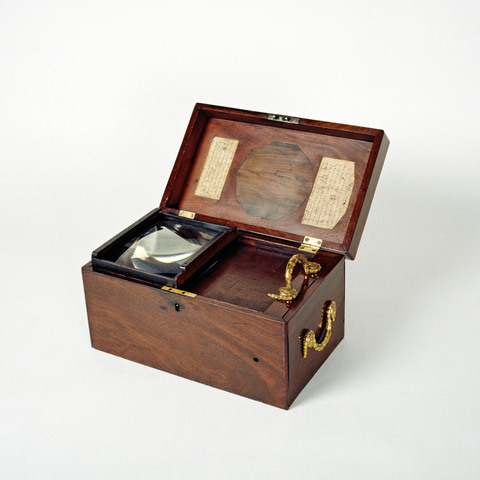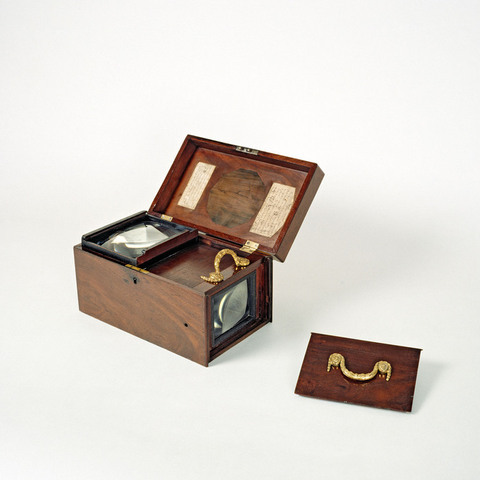Chambre noire
Fiche détaillée
Type de l'appareil
boîte en acajou portable par deux poignées ; couvercle à charnières, portant sur le dessus les armes du roi George III en laiton sur fond de velours brun ; lentille grossissante horizontale à l'intérieur de la boîte pour recevoir les images réfléchies par un miroir incliné (absent) et une lentille rectangulaire disposée à l'avant de l'appareil, lentille cachée ou découverte par un panneau de bois coulissant qui porte l'une des poignées en laiton ; deuxième lentille encadrée de bois interchangeable, pour "Portraicts and near objects" (mention manuscrite à la plume sur le bois) ; crémaillère pour faire avancer l'objectif en place, enchâssé dans un coffre rectangulaire en bois ; deux étiquettes d'instruction au revers du couvercle ; serrure pour fermer le couvercle
Auteurs
Storer William
Londres, 14 Lisle Street, Leicester Fields
Fabricants
William Storer
Londres, 14 Lisle Street, Leicester Fields
Utilisateurs
Storer William
Londres, 14 Lisle Street, Leicester Fields
Distributeurs
Informations non disponibles
Sujet du modèle
Informations non disponibles
Objectif
2 lentilles rectangulaires 10 x 13 cm et 10 x 13,5 cm ; une lentille rectangulaire 15 x 20,5 cm
Taille de l'objet
Ouvert :
Longueur : 41 cm
Largeur : 28.5 cm
Hauteur : 40.5 cm
Fermé :
Longueur : 41 cm
Largeur : 23.5 cm
Hauteur : 22 cm
Diamètre :
Informations non disponibles
Taille de la boîte de transport
Informations non disponibles
Remarques
Armes de George III en laiton sur le couvercle : couronne, deux lions et "Honi soit qui mal y pense - Dieu fait mon droit".
Au revers du couvercle, étiquette imprimée : "Royal accurate Delineator, to perform properly on Portraits, Landscape, Buildings, Paintings, &c., &c. (Field of View) any size, submit to the Royal Family Nobility, Artists, & Admirers of the Arts for their further Approbation. NB. attendance from N° 14. Lisle Street Leicester Square".
Etiquette manuscrite : "Royal Delineator. The Royal Delineator is an Optical Instrument that obviates the defects of the "Camera Obscura" has it does not require the Sun, is equally no full by Candle or Gas Light being has distinct accurate at the Edges as the Centre and much brighter than, the object to perform properly on Portraits Landscapes & Buildings. "Field of view any size". W. Storer, Patentee, 14 Lisle St. London".
Le Royal ou Accurate Delineator est l'une des chambres noires les plus perfectionnées du XVIIIe siècle. L'écrivain anglais Horace Walpole en possédait un exemplaire. Il écrit en 1777 : "Sir Joshua Reynolds et West sont fous de cet appareil et ce sera entièrement leur faute s'ils n'arrivent pas à supplanter Rubens en lumière et ombre, et tous les maîtres flamands en vérité".
Exemplaires recensés par Peter de Clercq : Science Museum, London, inv. 1924-474 ; Museum of the History of Science, Oxford, inv. 62524 ; Burton Constable Hall, near Hull, England ; Hertford Museum, Hertford, England ; Museum Boerhaave, Leiden, inv. 22542 ; Mathematisch-Physikalischer Salon, Dresden ; Sotheby's, London auction 7-8 March 1996. Un exemplaire gaîné de velours a été vendu sur eBay, en octobre 2005 (provenance Pays-Bas).
"[...] I had, with much labour and expence, by a new art or science, invented "An Optical Instrument, called An Accurate Delineator, which, amongst its many perfections, intirely obviates the Defects of the Camera Obscura, as it may not only be used without the Assistance of the Sun in the Day Time, but also equally of Use by Candle Light, for drawing the Human Face, inside of Rooms, Buildings, Perspectives, Landscapes, Foilage and Fibres of Trees and Flowers, it exactly representing the Same, large of small, with the true Outlines, Lights, Shades, and Colours", all which effects were new and discovered by me, and which I apprehend would be of great publick utility, and in regard I was the first and true inventor, and the same had not been practised or used by any other person or persons to my knowledge and belief, I therefore most humbly prayed His said Majesty to grant unto me, my executors, administrators, and assigns, His Letters Patent for the term of fourteen years, for the sole benefit and advantage of the said Invention ; His said Majesty, being therefore willing to give encouragement to all arts and inventions that may be for the publick good, did, by His Letters Patent under the Great Seal of Great Britain, bearing date at Westminster, the Fourth day of March, in the eighteenth year of His reign, give and grant unto me, the said William Storer, my executors, administrators, and assigns, His special licence, full power and authority, that I, the said William Storer, my executors, administrators, and assigns, should and might lawfully make, use, exercise, and vend my said Invention within that part of Great Britain called England, the Dominion of Wales, and Town of Berwick-upon-Tweed [...]. The accurate delineator may be made of various form, and the effects above mentioned arise from a new-invented application of lenses, mirrors, speculums, prisms, or mediums of lenses of glass, or any composition containing reflecting or refracting powers. The rays from the object are at first received on or conveyed to a mirror or speculum placed at a proper angle in the inside of a tube or box by one or more convex lens or medium of lenses before the mirror or speculum. In cases where the object is conveyed thro' a lens or medium of lenses must be applied to correct and illuminate the rays, and to receive from the mirror or speculum the rays from the objects conveyed thereon through the first-mentioned lens or medium of lenses ; but in cases where the rays from the objects are received in the first place on the mirror or speculum, a convex lens or medium of lenses must be placed fixed or moveable next after the mirror or speculum, to collect the rays from the mirror or speculum ; and at a proper distance from the first lens or medium of lenses must be applied one or more convex lens or medium of lenses to correct and illuminate the rays from the first lens or medium of lenses, by which means all rays that are spherically refracted through the first medium will be made parallel, and consequently all objects are accurately represented and all parts thereof equally illuminated on the lens or medium lenses so receiving and correcting the rays of the objects received from the mirror or speculum, or first lens or medium of lenses, and gives the most lively and exact representation of the objects, either by the light of the sun, moon, or any other light. In all cases the size of the aperture or medium through which the rays first pass must govern the size and powers of the correcting lens or medium, both contrary to the principals of the camera obscura. A prism, mirror, or speculum placed at a proper angle to reflect the image on the first lens or medium of lenses, mirroir, or speculum, the objects will be represented in their true shape, figure and form ; and a collecting of correcting lens or lenses, or medium of lenses, to collect or correct the rays from the images presented by a reflecting microscope, magick lanthorn, camera obscura, or other instrument of the like nature, instantly forms the accurate delineator, the principals of the accurate delineator being not so much in the form or figure of the instrument, as to collect and correct and illuminate the faint and imperfect rays from the objects received thro' these instruments" (William Storer, B.P. n° 1183, 29 juin 1778 : "An optical instrument called an Accurate Delineator").
Bibliographie
William Storer, B.P. n° 1183, 29 juin 1778 : "An optical instrument called an accurate delineator".
Peter de Clercq, The Leiden Cabinet of Physics, A Descriptive Catalogue, Leiden, Museum Boerhaave, 1997.
